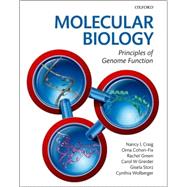
Note: Supplemental materials are not guaranteed with Rental or Used book purchases.
Purchase Benefits
What is included with this book?
| Genomes and the flow of biological information | |
| Biological Molecules | |
| The Chemical Basis of Life | |
| Chromosome Structure and Function | |
| The Cell Cycle | |
| Chromosome Replication | |
| Chromosome Segregation | |
| Transcription | |
| RNA Processing | |
| Translation | |
| Protein Modification and Targeting | |
| Cellular Responses to DNA Damage | |
| DNA Double-Strand Break Repair and Homologous Recombination | |
| Mobile DNA | |
| Genomics and Genetic Variation | |
| Methods in Molecular Biology | |
| Table of Contents provided by Publisher. All Rights Reserved. |
The New copy of this book will include any supplemental materials advertised. Please check the title of the book to determine if it should include any access cards, study guides, lab manuals, CDs, etc.
The Used, Rental and eBook copies of this book are not guaranteed to include any supplemental materials. Typically, only the book itself is included. This is true even if the title states it includes any access cards, study guides, lab manuals, CDs, etc.